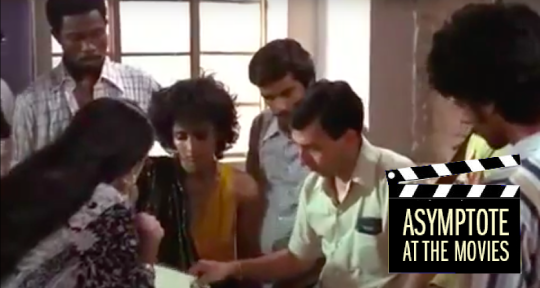Of her 1989 film, In Which Annie Gives It Those Ones, Arundhati Roy writes: “I loved the quirky, spontaneous performances. I loved the fact that there were no ‘beautiful’ people in it. I loved the egalitarian friendships between the boys and girls. I loved the corny clothes, the absurd glasses, the ridiculous hairdos, the uncertainty, the joy and the sadness of it . . . It was from another time . . . I ache for the innocence of it.” Indeed, the film is potent with the tender touches of youthful idealism, fearlessly authentic to its characterisations of young architecture students in 1970s India, and an early emblem of Roy’s intrepid criticisms against the evils of her time. In this edition of Asymptote at the Movies, Editor-at-Large for India Suhasini Patni speaks with Blog Editors Allison Braden and Xiao Yue Shan about the complex role Hinglish plays in the film, the depictions of class and social mobility, and how art can arise from the myriad places in which various languages meet.
Suhasini Patni (SP): Before Arundhati Roy became famous for her Booker Prize-winning novel and Pradip Krishen became an important environmentalist, they worked on the film In Which Annie Gives It Those Ones, which was screened late at night on Doordarshan in 1989, then largely forgotten by the Indian audience. However, it later went on to win two National Awards (both of which were returned to protest the government’s growing intolerance) and became a cult classic.
To the best of my knowledge, this is the first Hinglish film ever made in India. Critics found it difficult to categorize the language of the film; some called it an English language film—which does disservice to the mouthfuls of Hindi and Punjabi that form an integral part of the dialogue—and some called it a trilingual film, which doesn’t showcase the Indianness of the English spoken. English that is remolded to include mispronunciations and Hindi slang (“Kya maal hai. Hello sweetheart lovely,” says a catcaller to Radha).
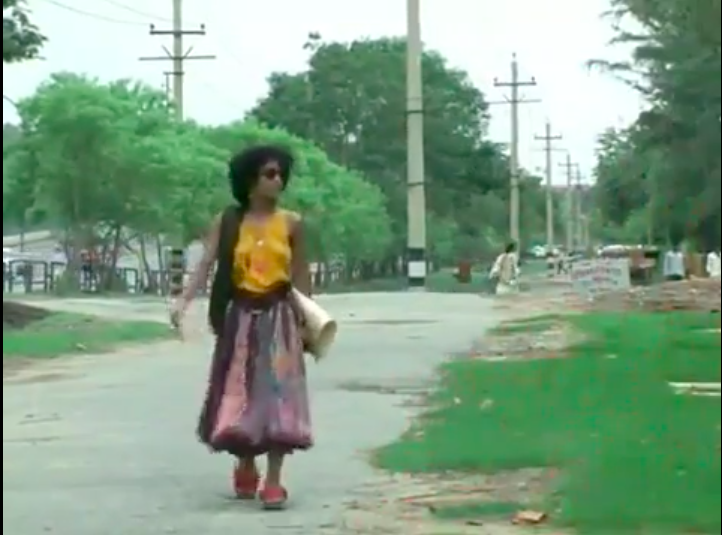
Discerning commentators found it difficult to admit an entire film existed in this “nonsense” language. Even the title itself is gibberish: In Which Annie Gives It Those Ones. The students in the film let us know what “those ones” are, but at the time of its release, the title was allegedly seen as inaccessible and alienating, and Roy was asked not to use it. But it’s exactly this mismatched, nonsensical language which makes for an endearing experience—a film ahead of its time, as people say.
The dialogue captures the porousness between Hindi and English. Code-switching in bilingualism is not new, but Hinglish, as Roy has written it, really grasps the way social mobility operates in a cosmopolitan city like Delhi. For the upwardly mobile, Hinglish is a language of survival. For those who cannot speak the hegemonic, pure, Sanskrit-ised Hindi, Hinglish helps to adapt to life in the capital. And in any case, North Indians have always spoken Hindustani, a Hindi that generously accommodates Urdu and other languages and dialects. Hinglish is arguably a “modern” version of Hindustani.
I’m interested in knowing what you think about the film, especially considering you’re not native Hindi speakers.
Allison Braden (AB): What a charming film! I agree that the movie’s collegial atmosphere and the students’ easy rapport depends largely on the code-switching; omitting the Hindi and Punjabi in favor of English only would have done away with one of the story’s most authentic elements. For viewers who don’t speak Hindi, some of the linguistic diversity naturally gets lost behind the subtitles, which appeared for the English, Hindi, and Punjabi dialogue in the version I watched, but the languages’ relationship to class remains evident. Arundhati Roy’s character, Radha, clearly struggles with the social mobility issue you bring up, which she articulates toward the end of the movie. She specifically mentions how her position as a student at the National School of Architecture requires her to speak a language that ninety percent of the country can’t understand. Social mobility is also explicitly referred to in the eponymous Annie’s initial thesis project—a plan to line India’s extensive train tracks with fruit trees and encourage the country’s flood of rural to urban migration to reverse course. Despite his enthusiasm for the idea—he even writes to the prime minister about it—his classmates respond dismissively. I was struck by the moment when his partner rebukes him after interpreting the plan as a suggestion that she return to her village. He explains that he’s speaking about a general issue, not her individual situation, but the exchange was such an effective illustration of how those larger issues affect so many individual lives.
Xiao Yue Shan (XYS): Far from being objectionable, for those of us who find language to be an object of fascination, the varying, generous, and emancipated dialogue of the film is one of its overarching attractions—endearing, as you say, Suhasini. Though, of course, I can imagine how difficult the melange may have been to navigate sans subtitles.
I think we are used to thinking of languages as being associated with certain levels of comfort based on our familiarities with them, but perhaps a willingness—or a submission—to consider language beyond its communicable facilities would be useful as we enter increasingly fluid and nonconformist linguistics in the impetus of globalisation. Acquainting oneself, to a certain extent, with the matrix of incomprehension would perhaps allow for a deconstruction of the hierarchy surrounding languages. The urge to understand can so often bleed into an impulse to imperialise—it’s an unfortunate consequence of how we’ve established the world as a battlefield of competing power dynamics. When we are confronted with language that we don’t immediately have access to, we tend to relativize it with our own discourse, revealing the fragmentation and othering that occurs when language is stripped of its historical and cultural context. I feel that there is space for a certain relief to enter the not-knowing state of an unfamiliar language, in which one can witness instead of interpret, absorb instead of adopt.
All that to say as a non-Hindi speaker, I was struck by the nature of the film as it engaged with language as a living, decolonised, and mutinous creature. It brought me to an arena in which to engage the musicality, behaviours, and tonal respects of Hinglish. There was such texture and kinetics in the freewheeling, unrestrained way these students spoke to one another; I love what Arundhati Roy wrote in her introduction to the screenplay: “I wasn’t interested in the head noddy, hand rubby thing. I was interested in the realism thing.”
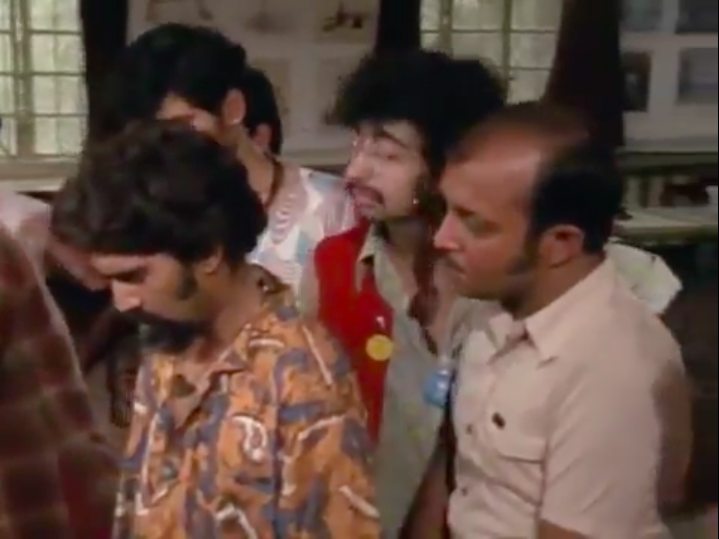
One thing that struck to me also was the language’s inextricable link to class, as you mentioned, Allison. When Radha was presenting to her professor, the English that she operated had a markedly different sound and fluency, and the professor, in turn, spoke a pointedly British and formalised edition of English, which evidently indicated his more conservative politics, and additionally established English as the language of professionalism and cultivation. The film very much invites us to notice this dichotomy, then defies it by exuberantly rejoicing in the freedom of expression as the students converse with one another, in a language that seems to be all their own. A language that says exactly what the speaker wants it to say, that the speaker wields, as opposed to a language that is rimmed in and stunted by the parameters of authority. I wonder—did you feel that the speech in the film was tactical in this way, presenting Hinglish as a product of liberation, as opposed to the other view, which is as a succumbing to the imperial language?
SP: You’re right in mentioning that the urge to understand can so often bleed into an impulse to imperialise. I always get nervous whenever a new movie in Hinglish comes out, thinking it’ll be performing the modernity it’s meant to in this global context of neo-imperialism. What I truly find charming about this particular film, therefore, is the authenticity of the dialogue. Not only is the language molded so that both Hindi incorporates English, and English incorporates Hindi, but also it allows for subtle humor that could not exist in a “pure” language. When Paapey can’t pronounce the word “grotesque,” but he remains unbothered by his friend correcting him—this makes sense to me as a Hindi speaker. He calls it “grotsks” because he is trying to pronounce the word phonetically, which is how Hindi works. These instances indicate that one is still translating Hindi into English—a reminder of class.
This also goes back to my point about Hinglish being a language of survival for the upwardly mobile. On the other hand, I find that Hinglish is often the language of convenience or merry-making for the upper-middle class. As you rightly point out, Radha can answer Yamdoot in her own type of aristocratic English. It’s a little bit of that “Empire Writes Back” kind of post-colonialism, wherein the empire is represented now by the English-speaking, Western classical-listening, upper-class, and upper-caste men. By the way, Yamdoot’s name is an ode to the God of Death “Yamraj,” which I thought was pretty interesting.
I think what Annie does is solidify this locally invented language into the Hindi/English lexicon. Hinglish for me was the main character of the film; the creative confusion of the languages pouring into one another echoed the feeling of the final jury presentation. I think the invention of Hinglish itself is a radical critique of Eurocentrism with its notions regarding language, and also its aversion to assimilating and merging.
I’m not sure if I can answer your question, Xiao Yue. I definitely lean towards the film presenting Hinglish as a product of liberation, but in the end, there are those who can switch from Hinglish to English, like Radha, and those who cannot. This reminds me of the scene right at the beginning of the film, when Arjun is playing the piano and singing. He says: “his memory lingers on.” But he deliberately mispronounces memory as mammary, which Radha points out, and they both laugh about it. I wonder what you make of that.
I want to complicate the question you presented: If Hinglish indeed is presented as a language of liberation, then what do we make of characters like Radha? The one who can switch from pure English to Hinglish. Is she dismantling the superiority attached to the English language by switching, or merely amusing herself with the conveniences attached to the Hinglish interaction? It’s worth noting that in the end, despite not presenting the type of thesis she was asked to, she passes, but Paapey and Kasozi do not.
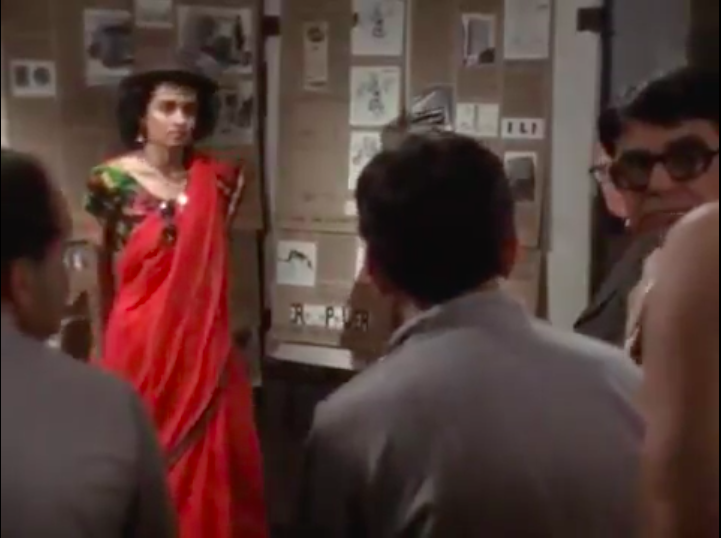
AB: Radha’s thesis presentation is a subtle argument that, despite myriad complexities and colonial histories, English can be a tool for liberation. She eloquently argued for drastic change, a nearly complete rejection of what the field of architecture represents. While other students have learned to flatter the egos of the jury members, Radha attacks what they stand for—and passes. Radha’s unusual outfit, a sari and fedora, manifests her internal struggle between catering to the jury or asserting her independence, a sartorial version of code-switching. Her language, and maybe the sari part of her ensemble, signals to the jury that she’s one of them, even though she doesn’t subscribe to their establishment ideals. English can help smuggle revolution into the upper echelons of India’s institutions. As Roy, who writes in English, has pointed out, Dr. B.R. Ambedkar’s 1936 treatise Annihilation of Caste—one of the most widespread and effective condemnations of the caste system—was written in English, which facilitated its dissemination among India’s many communities and their various languages, rather than confining it to his own Marathi community.
While code-switching can of course be a weapon and signal against English supremacy, I view Radha’s fluent mix of languages more so as a natural expression of self than a pointed and deliberate protest. She’s the multilingual product of a multilingual, many-faceted land, invented out of colonial convenience more than cultural or linguistic cohesion. Radha’s use of language marks her class, but her English fluency doesn’t make her less authentically Indian than some mythical monolingual Indian, untouched by the ravages of the British Empire. “Guilt in this case is an unhelpful sentiment,” Roy has said: “India as a country, a nation-state, was a British idea. So, the idea of English is as good or as bad as the idea of India itself. Writing or speaking in English is not a tribute to the British Empire . . . it is a practical solution to the circumstances created by it.” English is no doubt a language of prestige and power, but in a country with more than seven hundred languages, code-switching and translation are tools for survival—a way of life.
XYS: I find your point to be very poignant, Allison, and I think it’s true that Radha is uncompromisingly unbinding herself, with the tools and methods she has at hand, from the perpetuity of a structure that was not built to accommodate or understand her fear, her anger, or her frustrations. There are times when the individual must be emancipated from the greater scheme of what can be regarded; in this attention to innermost character, we have most closely a definition of freedom. It’s interesting to think that when linguistic identity is manifold, we do have the tendency to assume that there does exist a chewy center of genuine-self, genuine-speech. As duplicity in language becomes increasingly less of a tactic and more of an actual state of existence, over time, it is the insistence of a pure state that negates personhood.
As Suhasini brings up, however, I do think that the mutual teasing and corrections that goes on in Annie implies another layer to this condition—in which the self is not neatly contained but something that goes on to clash up against other selves, conversation being the most present form of this convergence. A close friend once told me: “I’m not interested in having a more native accent [when speaking English]; I think native English speakers should get used to the many different types of English that now exist.” Essentially, that as English becomes increasingly dominant in global conversations, its exactitudes must dissolve. I wonder, do we have a moral responsibility, as fluent English speakers, to act in service of this de-organisation of our language, so that the person we face in dialogue should also have the opportunity to be understood—or misunderstood—on their own terms, as opposed to on an established hierarchy of disciplined fluency? English is not my first language, and I recall that when I was learning it, the humiliation that occurs when mispronouncing a word was striking—less a frustration at my inability to learn the language immediately, but more of a deep-seated rage that I was not accurately representing myself in the public sphere. That sense of inadequacy does not invade this film, likely because race and expatriation are less foregrounded, but I am curious about this axis of representation, whether speech as a phenomenon of accuracy, which Roy insists upon, is ever sufficient. What does it mean to correct someone’s speech; what are the conditions we create when we do so?
SP: You bring up so many memories from my own experience of learning the English language, Xiao Yue. I remember wanting to speak English with “native” accuracy. It was not only the way to be recognized as someone worth talking to, but also the way towards economic progress. Personally, recognizing that English was an international language meant that not only did I want to achieve accuracy and fluency, but I wanted to instill the need to do so in others—toxically so. It’s so important what you bring up; I would lean towards it being a moral responsibility to be in service of the de-organization of the English language, but I think it extends out of being just a moral responsibility; as the film shows us, it’s something we can’t help but do. English has been melted down so much that it’s difficult to even decide what fluency or accuracy look like. Educators generally try to eliminate the use of grammatically defective language, but I wonder if we have a version of Standard English to adhere to, other than those spoken by ones have had the privilege to be brought up in English speaking households, where English acts like a (second) mother tongue. In that case, correcting someone’s English operates as a stark reminder of class. English has been co-opted by the upper class as a language of professionalism, but what Roy does is brilliantly manipulate the language that was given to us through colonialism into a rich language of her own.
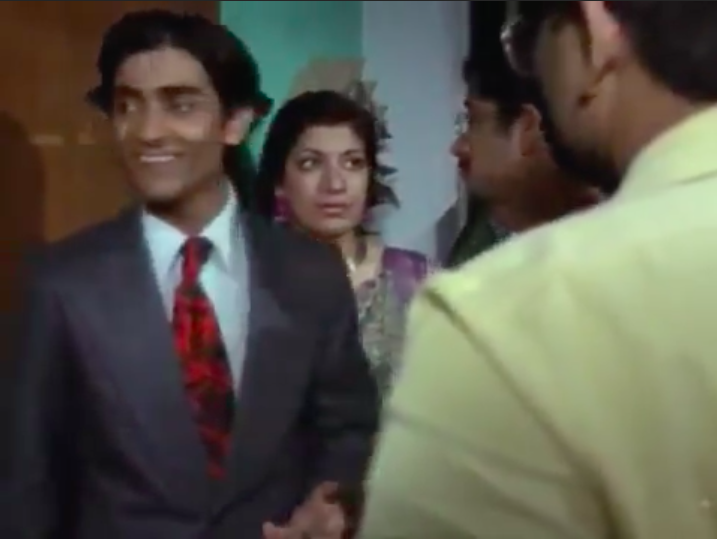
I’m glad you reminded me of her preface to Annihilation of Caste, Allison; the part you mention about English being a practical solution is probably the central idea behind the dialogue of the film too. Ultimately, with the rich diversity of India, English acts as a lingua franca, especially in university spaces where students meet people from different cultures. Here your point about English smuggling revolution into the upper echelons of India’s institutions is reaffirmed. Indians have always filled in the gaps between English and their native languages by creating hybrids such as Hinglish (and also Tanglish, Manglish, Kanglish, etc.). Even if a work is written in English, it is still translating the landscape of the community surrounding it.
Many authors in India who write in English are accused of harping for international recognition and attention. In her preface to the script, Roy says too that she believed writing the script in this language would possibly be seen as a “spoilt” thing to do. Although she doesn’t worry about losing out on the market, nor does she believe in carrying guilt over writing in English, I wonder what you make of the criticism that writers like Roy are spoilt. Do you find any truth in this claim at all? On the flipside of correcting someone’s English, what do you make of accusing someone of speaking in English in the first place?
AB: Rather than being “spoilt,” authors with multiple fluencies have the complicated privilege and burden of experiencing all the synthesis and conflict of translation within their own minds. This is certainly not an original observation, but Roy—and authors like her—demonstrate how an inner linguistic turmoil can be the source of and vehicle for great art. Roy’s thoughtful thinking and writing on this in particular are another kind of translation, missives from a multilingual mind and the republic for which it stands. Roy’s body of work remains just as urgent today as in 1989, when Annie was released, and it’s hard not to think about the film in the context of the devastating coronavirus crisis unfolding in India as we speak.
In The Guardian, Roy recently argued—in English, for the benefit of the global English-speaking community—that the skyrocketing number of coronavirus infections and deaths represents a crime against humanity. She leveled devastating criticism at Prime Minister Narendra Modi and his Bharatiya Janata Party, which has fomented Hindu nationalism since coming to power in 2014. The party has pushed for the use of Hindi as a national language and launched a “one nation, one language” campaign against the linguistic diversity Annie celebrates and grapples with. Suhasini, you mention how lots of English-speaking intellectuals in India (and elsewhere) are seen as pandering to a foreign audience. The criticism usually implies someone seeking personal fame and recognition, but in this moment, Roy’s ability to reach a global audience and eloquently communicate the horrors in India seems vital, and it reminds me of Radha, standing in front of that jury and passionately making her case.
The coronavirus is an invader, a force that will remake India through unimaginable violence. English, too, has made an indelible mark on the country, and you point out that part of Roy’s talent is her ability to “brilliantly manipulate the language that was given to us through colonialism into a rich language of her own.” Last year, Roy wrote of the pandemic as a portal, “a gateway between one world and the next.” Her words, while written about the pandemic, seem equally applicable to India’s ongoing struggle against English-language imperialism and Hindi nationalism. Her vision reflects the ethos that runs through Annie and has defined her work ever since:
We can choose to walk through it, dragging the carcasses of our prejudice and hatred, our avarice, our data banks and dead ideas, our dead rivers and smoky skies behind us. Or we can walk through lightly, with little luggage, ready to imagine another world. And ready to fight for it.
XYS: Yes, considering Roy’s avid and lifelong efforts of resistance and education, I also found it a heightened intrigue that during the closing sequence of the film, in which a foray into the various character’s futures are depicted in text on screen, Radha—the character Roy plays—is shown as having given up architecture to become a writer, and then drowning before finishing her first novel. Meanwhile, the titular Annie goes on to take a professorial position at the university. It is, in fact, a dual death of ideals from the two radical characters: one by peril, one by supplication. No doubt a winking knowingness on Roy’s part, the death of Radha further insinuates that inherent romanticism that pervades the righteous, growing years of young adulthood, in which the world exists as a series of possible resistances.

The effect of viewing this from the vantage point of Roy’s long, renowned career is to acknowledge the utility of young idealism, so often transient but vital with momentum, and desperate for mediums and platforms by which to manifest itself. And the pain of seeing these characters grow up and seek more traditional successes, to me, was indicative to how our young, vulgar, beautiful ideas of how progression occurs is not something that one grows out of or leaves behind, but violently stifled and euthanised. Suhasini, you had mentioned earlier that Radha passes her thesis review, but it appears as though that only happened because the jury was preoccupied with their lunch order during her presentation.
Ironically, Annie was also produced and broadcast in an India which was perhaps more permissive of errant counter-culture or bohemian-isms, as depicted in the film, which likely explains the film’s realist ease, its sensitive, cavalier intimacies. It’s worth noting that Roy and Pradip Krishen returned their National Film Award for Best Screenplay and Best Feature Film in 2015, following a series of brutal incidents that marked Prime Minister Narendra Modi and the BJP’s growing suppression of perceived dissent. With the “remaking of India through unimaginable violence”, as you say, Allison, In Which Annie Gives It Those Ones presents a rare microcosm of sobering nostalgia, in which a portrait of what was can articulate, with precision, again what one can looking toward.
Suhasini Patni is an English and creative writing graduate from Ashoka University. In 2019 she graduated summa cum laude from the Ashoka Scholar’s Programme and since then she’s worked as a teaching fellow, and visiting faculty at Nirma University. Her writing was short-listed for the Toto Funds the Arts, Creative Writing in English award, 2021. She’s a freelance writer at scroll.in and her work has appeared in The Tishman Review, A Quiet Courage, and a few other micro-fiction journals.
Allison Braden is Asymptote’s assistant blog editor.
Xiao Yue Shan is a poet and editor. shellyshan.com
*****
Read more on the Asymptote blog:

